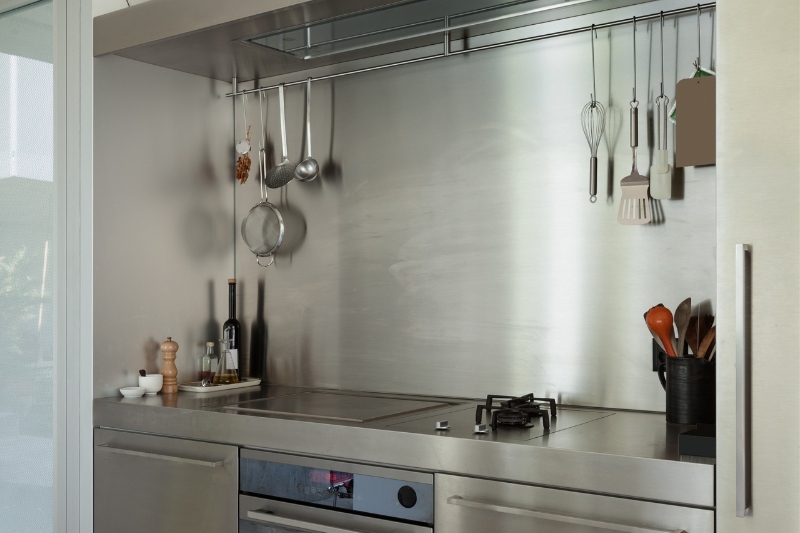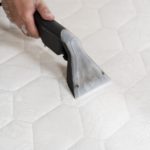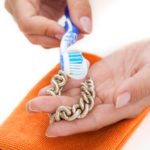Stainless-steel’s a fabulous material. The appeal’s right there in the name. A nice shiny immaculate metal that doesn’t readily rust.
However, just because it sends the Rust Fairy packing doesn’t mean it won’t play host to other unwanted visitors.
In fact, stainless-steel is a misnomer, as stains galore can make themselves very much at home on your shiny splashback.
What you need to know is what to do about these indecent interlopers, while avoiding making matters worse.
You need to know how to care for your stainless-steel like the sensitive soul it is. That’s what we’re all about here today.
Stainless-Steel – What Is It?

Quick science lesson. Throw some iron and chromium together (and some carbon if you’ve got any knocking around) in a great big melting pot, and out comes stainless steel.
Note—the process may well be a little more complex than I’m making it sound.
Anyway, the product is a wonder material that combines the usefulness of iron with a marked reluctance to rust. Which makes it just about perfect for all manner of applications, such as that splashback of yours.
Are Stainless-Steel Splashbacks Hard to Clean?
Stainless-steel has the same cleanability (real word, promise) as glass. So, it should be a doddle to keep your splashback looking sensational.
Alas, it’s not as easy as you might think, mainly because of awkward taps and other sink furniture that get in the way of what you might call optimal access levels.
However, with patience you should be able to get into your splashback’s nooks and crannies. That’s great news. Because nobody wants to dismantle a tap.
How to Clean a Stainless-Steel Splashback
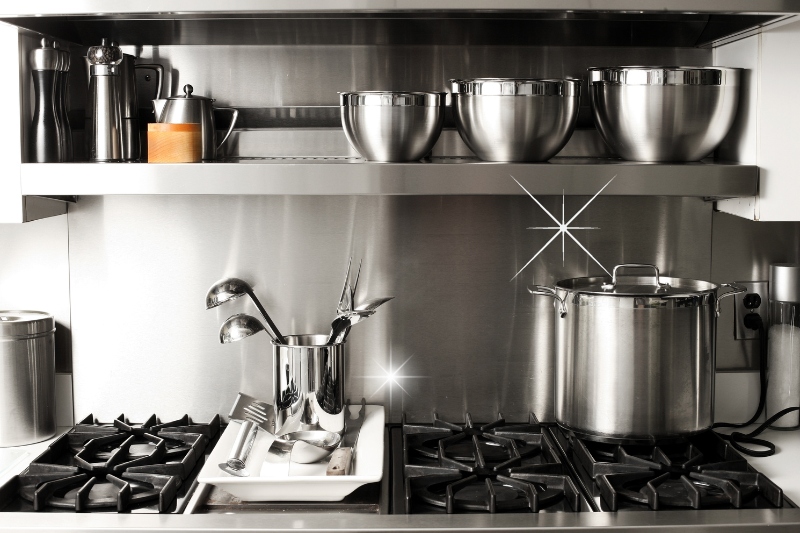
Much like the nowadays rightly frowned-upon pastime of cat-skinning, there’s more than one way to clean your stainless-steel splashback.
The most common impairments that will affect it include scale build-up and water marks.
To deal with these kinds of things you might want to use a specially designed stainless steel cleaner spray.
Method’s Stainless Steel Cleaner is worth a go, as is Astonish’s Stainless Steel Cleaner & Sponge.
Method’s environmental credentials are great, but what’s even better for the planet and for your pocket is a natural cleaning approach, so let’s concentrate on some of the best.
1. Just wipe away
If it’s just fingermarks you’re seeing, you can despatch those with a quick swipe of a soft cloth. Simple as that.
2. Hot water
Sometimes, all you need is some water at a hot enough temperature to make inroads into the stain.
Stick on some rubber gloves to protect your hands against the heat, then get some kitchen towel dunked in nice hot water and rub that stain away.
Don’t rub too hard though or you’ll leave traces of your rubbing frenzy for all to see.
3. Washing-up liquid
A few drops of washing-up liquid in some warm water will do wonders.
Give a sponge a quick soaking in it then wipe the splashback over, making sure you’re using not using the scourer side, should there be one on your sponge of choice.
Make sure you dry it off afterwards or you may leave marks. Once you’ve dried it, you’ll be greeted with a nice shiny face, in which you might be able to see your own nice shiny face.
4. Vinegar
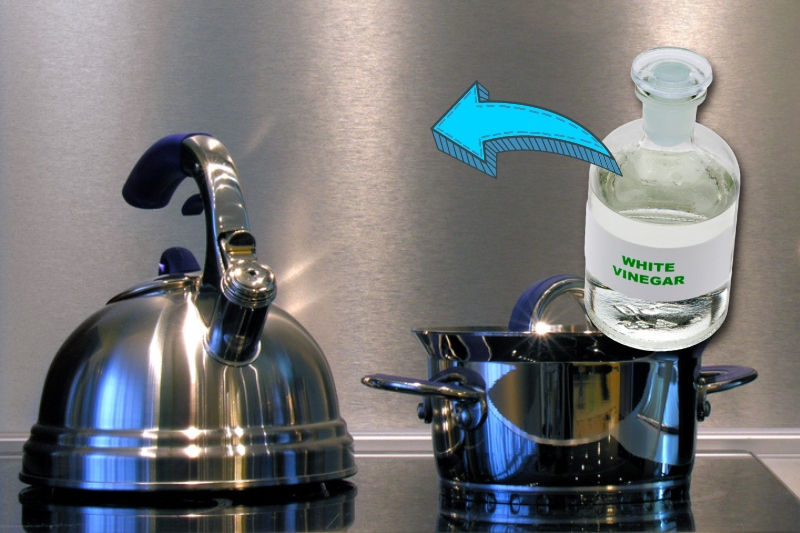
The range of applications for vinegar is mind-blowing. What it can do for your cleaning makes what it can do for chips look pretty paltry by comparison.
There should be some kind of recognition for our humble acetic acid-based accessory. A National Vinegar Day, perhaps. Or at the very least a medal. Which could be kept clean and shiny with a dose of vinegar.
Here’s how vinegar makes a splash with stainless-steel. Get some white vinegar and mix it with an equal quantity of water. Don’t use undiluted vinegar on your stainless-steel splashback, as it could damage it.
For extra cleaning power, add a spoonful of washing-up liquid and a spoonful of olive oil.
Dunk a soft cloth in your magic mixture and give that splashback a good wiping. Then, once you’ve wiped on, wipe off. Just like The Karate Kid. Mr Miyagi would be proud of you.
5. Oil and lemon
This one’s good if you’re against the clock and need to dress some salad while you get that splashback looking fine.
Mix some lemon juice and olive oil together, apply to a soft cloth and wipe on your splashback. Clean off with a microfibre cloth.
Any leftover mixture will be greatly appreciated by your romaine and curly endive leaves.
6. Bicarbonate of soda
Another stalwart of the clean scene, bicarbonate of soda has brought more joy to more houses than you can measure.
It never lets you down, and takes immense pleasure in seeing off stains and upending unpleasantness.
With splashbacks, what you need to do is make a bicarb paste with two tablespoons of bicarbonate of soda mixed with one tablespoon water.
Rub your paste onto your splashback with a soft cloth, then leave for a minute. Get some warm water onto it and wipe off with a microfibre cloth.
7. Black soap
OK, so this might not be in everyone’s cupboards, but it’s about time it was. Why? Because it’s a fabulous, 100% biodegradable, antimicrobial plant-based cleaner.
It’s good for skin too, so feel free to whack a bit all over while you’re about it.
Mix some soap with some water to make a lotion consistency. Then go ahead and apply to whatever needs cleaning. Wipe off and be amazed.
8. Window cleaner
Get your window cleaner onto the job. By this, I mean use the spray you use on your windows. I don’t mean ask whoever cleans your windows to clean your splashback. Unless they’re like that. You know them better than me.
So, this is back to the sprays, albeit one that you might not have thought to use.
Spray on and wipe off with a dry cloth, or, if newspaper’s your thing, try this. The best window cleaning sprays will be smear-free so you should get a very nice steel finish from your George Formbying.
Things You Shouldn’t Use to Clean a Stainless-Steel Splashback
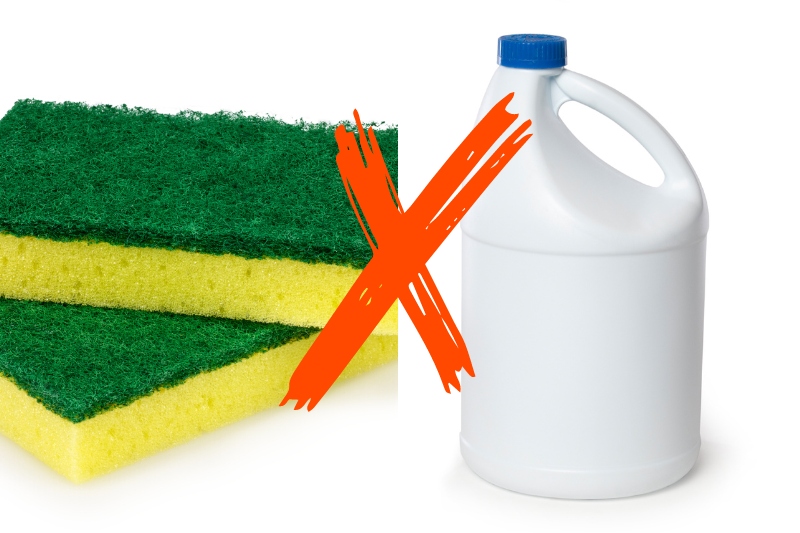
There are some real no-no’s when it comes to deciding what to use on your stainless-steel splashback. Here are the worst offenders.
1. Abrasive cloths or sponges
Treat that stainless steel like a loved one’s skin. Lavish care and gentleness on it. Don’t scrub or scour or you’ll end up with some nasty marks. And/or a cross significant other.
2. Bleach
Don’t go near this stuff when cleaning stainless steel—it gives stainless steel a nasty case of corrosion.
3. Undiluted descaler
Always mix any descaler/limescale remover with water, as per instructions. Don’t be tempted to give patches of scale a chemical roundhouse with neat descaler—you’ll scar that splashback for life.
4. Undiluted vinegar (or any other acid)
Wonderful though vinegar is, you need to rein it in a little with some water. It’s just too strong for its own good. And that of the splashback.
Keeping Your Stainless-Steel Splashback Clean
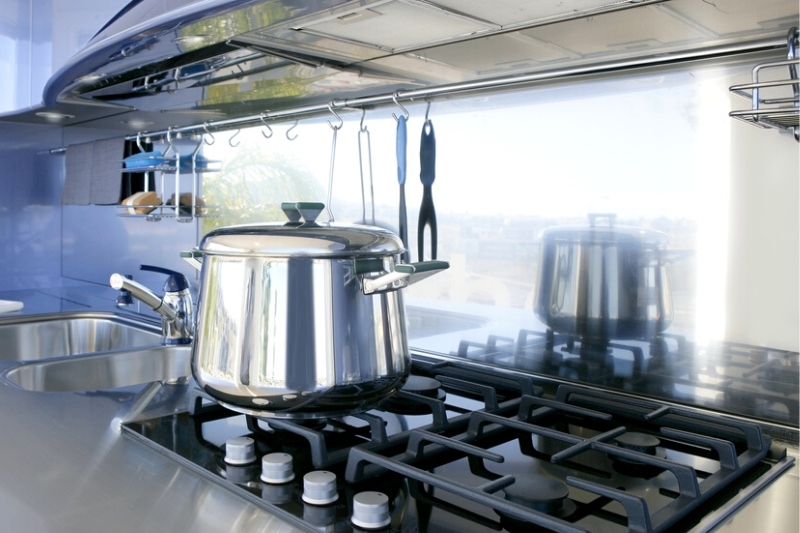
So, going forward, you know what to do to keep your stainless-steel splashback looking fantastic using common and cheap household ingredients.
As with all these things, it makes sense to keep on top of matters by cleaning little and often. Tackle marks as they crop up and send those stains packing. That way your trips to the sink will always be shiny ones.

Martin’s life revolves around films, dogs and food, but rarely all at the same time. At least two out of these three like to give clothes and furniture a hard time, and Martin enjoys discovering and writing about new ways to stop them doing their worst.
